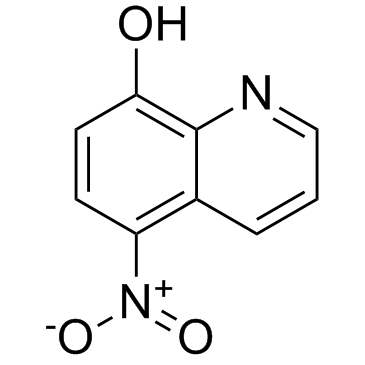Nitroxoline

Nitroxoline structure
|
Common Name | Nitroxoline | ||
|---|---|---|---|---|
| CAS Number | 4008-48-4 | Molecular Weight | 190.156 | |
| Density | 1.5±0.1 g/cm3 | Boiling Point | 419.0±35.0 °C at 760 mmHg | |
| Molecular Formula | C9H6N2O3 | Melting Point | 181-183ºC | |
| MSDS | Chinese USA | Flash Point | 207.2±25.9 °C | |
| Symbol |

GHS06 |
Signal Word | Danger | |
|
Development of new cathepsin B inhibitors: combining bioisosteric replacements and structure-based design to explore the structure-activity relationships of nitroxoline derivatives.
J. Med. Chem. 56(2) , 521-33, (2013) Human cathepsin B has many house-keeping functions, such as protein turnover in lysosomes. However, dysregulation of its activity is associated with numerous diseases, including cancers. We present here the structure-based design and synthesis of new cathepsi... |
|
|
Redox-based inactivation of cysteine cathepsins by compounds containing the 4-aminophenol moiety.
PLoS ONE 6(11) , e27197, (2011) Redox cycling compounds have been reported to cause false positive inhibition of proteases in drug discovery studies. This kind of false positives can lead to unusually high hit rates in high-throughput screening campaigns and require further analysis to dist... |
|
|
Experimental and theoretical quantum chemical investigations of 8-hydroxy-5-nitroquinoline.
Spectrochim. Acta. A. Mol. Biomol. Spectrosc. 96 , 506-16, (2012) The FT-IR and FT-Raman spectra of 8-hydroxy-5-nitroquinoline have been recorded in the regions 4000-400 and 4000-100 cm(-1), respectively. The spectra were interpreted in terms of fundamentals modes, combination and overtone bands. The normal coordinate analy... |
|
|
[The characteristics of extracting 2-acetylamino-5-nitrothiazole and 5-nitro-8-hydroxyquinoline from aqueous solutions].
Sud. Med. Ekspert. 37(3) , 26-8, (1994)
|
|
|
Nitroxoline (8-hydroxy-5-nitroquinoline) is more a potent anti-cancer agent than clioquinol (5-chloro-7-iodo-8-quinoline).
Cancer Lett. 312(1) , 11-7, (2011) Clioquinol has been shown to have anticancer activity both in vitro and in vivo. The present study compared the cytotoxicity of clioquinol with six analogues using human cancer cell lines. Of the analogues tested, 8-hydroxy-5-nitroquinoline (NQ) was the most ... |
|
|
The urinary antibiotic 5-nitro-8-hydroxyquinoline (Nitroxoline) reduces the formation and induces the dispersal of Pseudomonas aeruginosa biofilms by chelation of iron and zinc.
Antimicrob. Agents Chemother. 56(11) , 6021-5, (2012) Since cations have been reported as essential regulators of biofilm, we investigated the potential of the broad-spectrum antimicrobial and cation-chelator nitroxoline as an antibiofilm agent. Biofilm mass synthesis was reduced by up to 80% at sub-MIC nitroxol... |
|
|
In vitro activity of the chelating agents nitroxoline and oxine against Mycobacterium bovis BCG.
Int. J. Antimicrob. Agents 18(6) , 579-82, (2001) The chelating antibiotic nitroxoline (5-nitro-8-hydroxyquinoline) showed a bacteriostatic effect at a concentration of 10 microM for Mycobacterium bovis BCG. At higher concentrations the compound showed moderate cidal activity against growing bacilli. In cont... |
|
|
Effects of subinhibitory concentrations of nitroxoline on the surface properties of Escherichia coli.
Folia Microbiol. (Praha) 45(6) , 485-90, (2000) Nitroxoline (5-nitro-8-quinolinol; NIQ) at subinhibitory concentrations (sub-MIC) decreased the adherence of uropathogenic Escherichia coli to catheter surface and significantly enhanced cell surface hydrophobicity. The surface hydrophobicity increased in the... |
|
|
Electrochemistry of the antibacterial and antifungal drug nitroxoline and its determination in bulk form, pharmaceutical formulation and human blood.
Bioelectrochemistry 80(2) , 162-8, (2011) Nitroxoline has been reduced at the mercury electrode in buffered solutions (pH 2-11) in two irreversible cathodic steps. The first step was attributed to reduction of -NO(2) group to the hydroxylamine stage and the second one to reduction-saturation of the C... |
|
|
Substituted oxines inhibit endothelial cell proliferation and angiogenesis.
Org. Biomol. Chem. 10(15) , 2979-92, (2012) Two substituted oxines, nitroxoline (5) and 5-chloroquinolin-8-yl phenylcarbamate (22), were identified as hits in a high-throughput screen aimed at finding new anti-angiogenic agents. In a previous study, we have elucidated the molecular mechanism of antipro... |